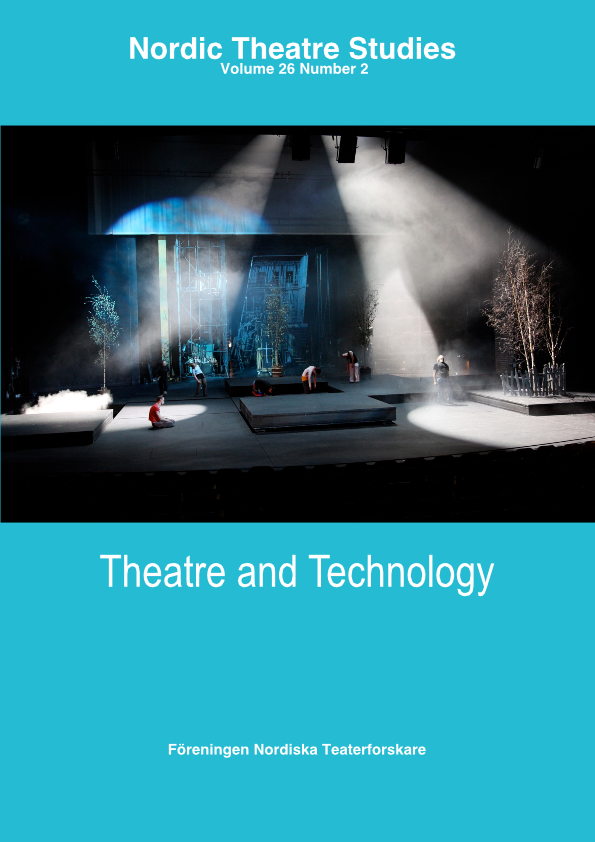The Power of Illusion
DOI:
https://doi.org/10.7146/nts.v26i2.24303Keywords:
stage technology, court masque, late Georgian pantomimeAbstract
In this article, I examine how two English theatrical phenomena used stage technology to produce illusions for certain political ends. The two phenomena of interest are the court masque of the early 1600s and the illegitimate genres of the late Georgian London theatre. My focus will be on the latter, through an examination of the pantomime The Picture of Paris – opening at Covent Garden in 1790. Whereas a political reading of the court masque is well established in theatre studies, the same cannot be said regarding a political understanding of the theatre culture of the late Georgian period. Furthermore, those who have focused on the political aspects of this theatre culture have not been interested in the role played by stage technology. This is where this article aims to contribute to the existing body of knowledge. Although the court masques and the illegitimate genres used much of the same stage technology, they differed in how they used it and to what political ends. Whereas the masque could be understood as a conservative statement of royal powers, asserting their right to rule, the illegitimate genres approached the governing powers and policies in a more subversive manner. Late Georgian cultural politics, censoring the spoken word on stage and patenting the performance of tragedy and comedy, gave rise to new theatrical genres where visual aspects – by legal necessity – took centre stage. The resulting spectacular theatre of action and visual image was exempt from government censorship, making possible a special kind of political freedom of expression in these genres. It was during performance, through their use of dumb shows, setting, stage machinery and special effects that government criticism could unfold within these genres.References
H. Barthels and P. I. Düringer, Theater-Lexikon, Otto Wigand, Leipzig 1841.
Christopher Baugh, Theatre, Performance and Technology, Palgrave Macmillan, Basingstoke 2005.
Christopher Baugh, “Shakespeare and the Rhetoric of Scenography 1770-1825” in Shakespeare in Stages, Christine Dymkowski, ed., Cambridge University Press, Cambridge 2010.
Christopher Baugh, “Philippe James de Loutherbourg and the early pictorial theatre: some aspects of its cultural context” in Themes in Drama, vol. 9: The Theatrical Space, Cambridge University Press, Cambridge 1987.
Oscar Brockett, History of the Theatre, 6th ed., Allyn and Bacon, Boston 1991.
Kari Gaarder Losnedahl, ed., Den teatrale illusjon, Bergen Museum, Bergen.
Jon Mee, “The Magician No Conjuror: Robert Merry and the Political Alchemy of the 1790s” in Unrespectable Radicals?, Michael T. Davis and Paul A. Pickering, eds., Ashgate, Aldershot 2008.
Jane Moody, Illegitimate Theatre in London, 1770–1840, Cambridge University Press, Cambridge 2000.
Allardyce Nicoll, The Development of the Theatre, 5th ed., Harrap, London 1966.
Stephen Orgel, The Illusion of Power, University of California Press, Berkeley 1975.
George Rowell, The Victorian Theatre, 1792–1914, Clarendon Press, Oxford 1967.
Sebastian Serlio, “The Stage” in The Renaissance Stage, Barnhard Hewitt, ed., University of Miami Press, Coral Gables Florida 1958.
William H. Sewell, “The concept(s) of culture” in Beyond the cultural turn, Victoria E. Bonnell, Lynn Hunt, eds., University of California Press, Berkeley 1999.
Roy Strong, Art and Power, The Boydell Press, Suffolk 1984.
David Worrall, Theatric Revolution, Oxford University Press, Oxford 2006.
David Worrall, The Politics of Romantic Theatricality, 1787-1832, Palgrave Macmillan, Basingstoke 2007.
Downloads
Published
How to Cite
Issue
Section
License
The copyright belongs to the authors and Nordic Theatre Studies. Users can use, reuse and build upon the material published in the journal but only for non-commercial purposes. Users are allowed to link to the files, download the files, distribute the files on a local network (preferably by links), upload the files to local repositories if their institutions require them to do so, but not republish the files without proper agreements with the journal and the author.

